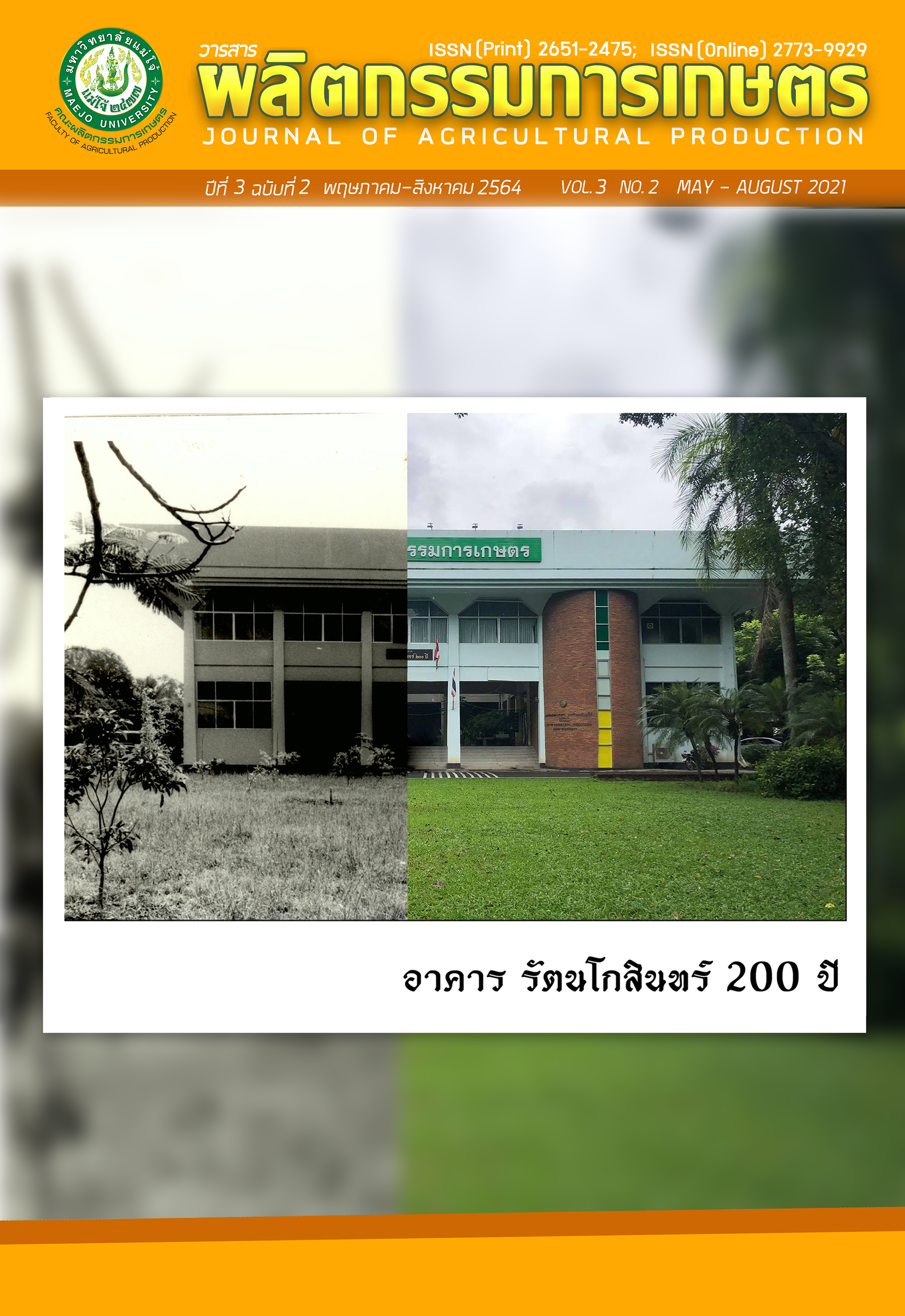Determination of The Optimum Concentration of Polyethylene Glycol 6000 for In-house Maize Seedling Screening System Against Osmotic Stress
Main Article Content
บทคัดย่อ
One of the breeding strategies to shorten a breeding process is selecting on early growth stage with correlated secondary traits. In vitro screening method with Polyethylene glycol 6000 is widely used due to it is more controllable and convenience for inducing osmotic stress to plants. Our In-house screening system was used to find the proper concentration of PEG solution on maize seedling which was the objective of this study. The experiment was conducted in Factorial in RCBD with 2 blocks. The first factor was 7 different concentrations of PEG solution in which caused different osmotic potentials of solution. Whereas the second factor was 4 maize varieties: 2 inbred lines and 2 commercial hybrid varieties. Maize seedlings were treated with the protocol of in-house screening system and were collected for 10 phenotypic traits. The results showed the significant effects of PEG 6000 concentration, maize variety and their interaction on many traits. Moreover, it was found that PEG concentrations that causes statistical changes of treatment means when compared with its control (0% PEG) were different at each trait. For example, the proper concentration was 20% PEG for root to shoot ratio while that of the other traits was different. However, PEG of 25% was recommended for being the effective concentration since this level of stress showed the statistical effect on 8 out of 10 traits. However, in case that a list of phenotypic traits might be changed, the effective PEG concentration for the new list of phenotypic traits should be re-considered. In addition, this study showed that two characteristics, shoot area and primary root length, which were extracted from image processing, shoot area showed strong relationship with leaf greenness (-0.42), shoot weight (0.93), root weight (0.63), total fresh weight (0.89), shoot dry weight (0.66) and root to shoot ratio (-0.50). Therefore, it is another interesting trait that might be used in seedling screening because it was easy to extract from the image processing whereas primary root length contrarily had weak correlation with the other 9 traits of seedlings.
Article Details

อนุญาตภายใต้เงื่อนไข Creative Commons Attribution-NonCommercial-NoDerivatives 4.0 International License.
เอกสารอ้างอิง
Abràmoff, M.D., P.J. Magalhães and S.J. Ram. 2004. Image processing with Image. J. Biophotonics International 11(7): 36-42.
Akinwale, R.O, F.E. Awosanmi, O.O. Ogunniyi, A.O. Fadoju. 2018. Determinants of drought tolerance at seedling stage in early and extra-early maize hybrids. Maydica 62: 1-9.
Anithakumari, A.M., O. Dolstra, B. Vosman, R.G.F. Visser and C.G. van der Linden. 2011. In vitro screening and QTL analysis for drought tolerance in diploid potato. Euphytica 181(3): 357-369.
Basal, H., C.W. Smith, P.S. Thaxton and J.K. Hemphill. 2005. Seedling drought tolerance in upland cotton. Crop Science 45(2): 766.
Bibi, A., H.A. Sadaqat, M.H.N. Tahir and H.M. Akram. 2012. Screening of sorghum (Sorghum bicolor var Moench) for drought tolerance at seedling stage in polyethylene glycol. Journal of Animal and Plant Sciences 22(3): 671-678.
Biswas, J., B. Chowdhury, A. Bhattacharya and A.B. Mandal. 2002. In vitro screening for increased drought tolerance in rice. In Vitro Cell. Dev. Biol. Plant 38(5): 525-530.
Bolaños, J. and G.O. Edmeades. 1991. Value of selection for osmotic potential in tropical maize. Agronomy Journal 83(6): 948.
Dhanda, S.S., G.S. Sethi and R.K. Behl. 2004. Indices of drought tolerance in wheat genotypes at early stages of plant growth. Journal of Agronomy and Crop Science 190(1): 6-12.
Kim, Y., S. Shanmugasundaram, S. Yun, H. Park and M. Park. 2001. A simple method of seedling screening for drought tolerance in soybean. Korean J. Crop Sci. 46(4): 284-288.
Li, R., P. Guo, B. Michael, G. Stefania and C. Salvatore. 2006. Evaluation of chlorophyll content and fluorescence parameters as indicators of drought tolerance in barley. Agric. Sci. China 5: 751-757.
Lobet, G., L. Page`s and and X. Draye. 2011. A Novel image-analysis toolbox enabling quantitative analysis of root system architecture. Plant Physiol 157(1): 29-39.
Marcinska, I., I. Czyczyło-Mysza, E. Skrzypek, M. Filek, S. Grzesiak, M.T. Grzesiak, F. Janowiak, T. Hura, M. Dziurka, K. Dziurka, A. Nowakowska and S.A. Quarrie. 2012. Impact of osmotic stress on physiological and biochemical characteristics in drought-susceptible and drought-resistant wheat genotypes. Acta Physiol. Plant 35(2): 451-461.
Michel, B.E. and M.R. Kaufmann. 1973. The osmotic potential of polyethylene glycol 6000. Plant Physiol. 51(5): 914-916.
Mohammadkhani, N. and R. Heidari. 2008. Water stress induced by Polyethylene Glycol 6000 and sodium chloride in two maize cultivars. Pak. J. Biol. Sci. 11(1): 92-97.
Ogawa, A. and A. Yamauchi. 2006. Root osmotic adjustment under osmotic stress in maize seedlings 1. transient change of growth and water relations in roots in response to osmotic stress. Plant Prod. Sci. 9(1): 27-38.
Pannim, W., C. Chutteang, W Utkhao, S Sukkhaeng, S, Promdang and Suntaree Yingjajaval. 2020. Stomatal and photosynthetic response to polyethylene glycol induced drought stress of Thai jasmine rice (Oryza sativa L. ssp. indica cv. KDML105) during vegetative stage. Agricultural Sci. J. 51(2): 90-106.
Ramzan, J., M. Aslam, M. Ahsan and F.S. Awan. 2019. Selection of screening criteria against drought stress at early growth stages in maize (Zea mays L.). Pak. J. Agri. Sci. 56(3): 633-643.
Sakthivelu, G., M.K. Akitha Devi, T. Rajasekaran, G.A. Ravishankar, T. Nedev and G. Kosturkova. 2008. Droughtinduced alternations in growth, osmotic potential and in vitro regeneration of soybean cultivars. Gen. Appl. Plant Physiology Special Issue 34(1-2): 103-112.
Salungyu, J., S. Thaitad, A. Bucksch, J. Kengkanna, P.J. Saengwilai. 2020. From lab to field: Open tools facilitating the translation of maize root traits. Field Crop Research. 255, 107872.
Wani, S.H., P.A. Sofi, S.S. Gosal and N.B. Singh. 2010. In vitro screening of rice (Oryza sativa L) callus for drought tolerance. Commun. Biometry Crop. Sci. 5(2): 108-115.
Xie, Q., K.M.C. Fernando, S. Mayes and D.L. Sparkes. 2017. Identifying seedling root architectural traits associated with yield and yield components in wheat. Ann. Bot. 119(7): 1115-1129.


